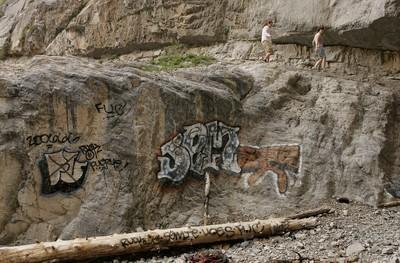Las Vegas man sought for questioning

In what they say is the first federal felony graffiti case in Southern Nevada, police are looking for a 19-year-old Las Vegas man to question him about 12-foot-long swaths of graffiti spay-painted on rock walls and logs at Big Falls on Mount Charleston.
Las Vegas police Detective Scott Black of the Gang Crimes Bureau and U.S. Forest Service Law Enforcement Officer Kevin Hart said that one of the spray-painted monikers found in the wilderness above Kyle Canyon matched that of another graffiti tagging that Steven Speakman has been arrested for in the Las Vegas Valley.
They declined to say Speakman is a suspect in the case.
“He does have prior involvement with graffiti,” Black said of Speakman, a 5-foot-6, blue-eyed young man with short blond hair. “There is probable cause that he (Speakman) is involved with this. We have made attempts to locate him but his current whereabouts are unknown.”
Black and Hart said they have identified juvenile suspects in the Big Falls graffiti case and will submit information to authorities Monday to obtain felony arrest warrants for federal prosecution.
“This is going to be groundbreaking because we’re going after them federally,” Black said. “It should send a message to these guys that if you’re going to go out and vandalize national parks, you’re going to have both agencies going after you.”
If they are arrested and convicted, Hart said the suspects could spend up to six months in jail and have to pay $5,000 fines in addition to paying restitution for the cost of removing the graffiti.
When Hart hiked to Big Falls on June 12 to examine evidence and document the crime scene, he shook his head and said “It makes no sense” why someone would endure a two-hour, round trip over rugged terrain to tarnish the natural beauty of a wilderness area.
He consulted Black, an expert on urban graffiti vandalism, to identify suspects.
“Their motivation is fame,” Black said of the Big Falls vandals.
He claimed that Speakman “did vast amounts of damage in Las Vegas using the same tag name.”
At Big Falls, the vandals left puffy, oversized white letters, outlined in blue and others in orange. There were black letters that spelled, “PYRO,” below the image of a devil’s face and the “Y” shaped like pitchfork.
A supposed date appeared on the east wall, “200666.” Across from it on the west face, was a shoulder-high inscription in black: “I am traisng (sic) graffiti to far away places.”
Twelve teenagers from a correctional camp, the Spring Mountain Youth Camp, chiseled away the spray paint this month. The U.S. Forest Service contracts with the Clark County youth camp to maintain trails and provide labor for upgrades in the Spring Mountains.
Black said the graffiti problem for the most part “has gone unchecked in Las Vegas for several years.” He said a tougher law, which he wrote and was passed by the Legislature this year, will give police more leverage to crack down on graffiti vandals beginning in October.
He said he hopes the new law and the potentially precedent-setting Big Falls case will keep urban graffiti vandalism in check and prevent it from spreading to areas outside the Las Vegas Valley. Of particular concern are Hoover Dam, Lake Mead, Red Rock Canyon and other public lands and structures managed by the Bureau of Land Management, the National Park Service, the U.S. Forest Service, the U.S. Fish and Wildlife Service and the Bureau of Reclamation.
BLM spokeswoman Kirsten Cannon said recent incidents in Red Rock Canyon National Conservation Area include an arson attack on a portion of Red Springs boardwalk and vandalism of petroglyphs and interpretive panels.
“We have a two-pronged approach to solve the issue: frequent patrols by law enforcement and education about the value of public lands’ resources,” Cannon said.
“We also have an active volunteer base who serve as site stewards,” she said.
Black said the Big Falls case “is probably the best case we’ve done in cooperation with the U.S. Forest Service. … This is the first time the case is solid and is going to be prosecuted federally.”
Despite the effort to remove spray paint from the base of the cathedral-like rock face at Big Falls, “the bottom line is that is forever altered,” Black said. “That was permanent damage to a federally protected natural feature. It’s a greater crime,” he said.
The so-called “tag crew” who left the graffiti is by definition a gang because the crew consists of at least three people who are involved in an ongoing pattern of crime, Black said.
That means anyone convicted in the Big Falls case could face double penalties for a gang-motivated crime.
“We have been successful doing gang enhancements on graffiti crimes,” Black said.












